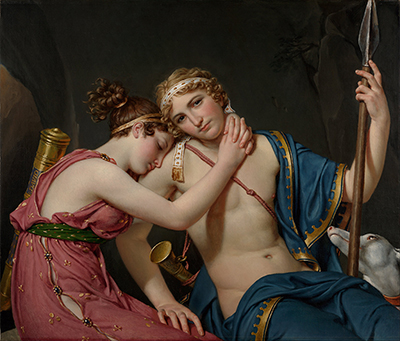Jacques Louis David produced The Farewell of Telemachus and Eucharis in 1818, just a few years after defeat at the Battle of Waterloo which caused uncertainty in the artist's personal life.
The artist would use Greek culture as inspiration for much of his work and in this case we find a scene derived from French novel Les Aventures de Télémaque from 1699, which was based on elements of Odyssey, ancient poems from Homer. David would bring these texts to life with a style which went into incredible detail, underlining why he was considered a master of realism, albeit within his Neo-classical style. He constantly revisited themes from Greek literature for inspiration and found it to be almost unlimited in the opportunities that it brought him. He may well also have appreciated the fashion and architecture from that ancient period, which again was ideally suited to his immaculate technical abilities.
Within this picture, Telemachus, son of Odysseus, would fall deeply in love with Eucharis, both of whom we see here. He looks at the viewer with an honest expression which suggests both happiness to be with this woman, but also an underlying concern about another matter. The matter turns out to be his task of finding his lost father, meaning he will shortly need to leave behind the love of his life. This type of romantic turmoil is typical of ancient literature, though may have been again expanded upon through the work of the French novelist much later. The scenario is added to visually with the weapons being held by the male figure, whilst the attractive young woman holds him closely, perhaps for the last time.
In line with the fashion of the period, both are dressed in beautiful tunics, wth Telemachus' opened up to allow the artist to display his strong, athletic physique which again plays into the story of this attractive couple being forced apart by circumstances and duty. The artist did portray his male figures as particularly young during this period of his career, as also found with the male figure in Love and Psyche of a year earlier. The later piece can now be found at the J. Paul Getty Museum in Los Angeles, United States. It sits alongside many other major artworks from a variety of periods and movements, including highlights such as Irises by Vincent van Gogh, Portrait of Alfonso d'Avalos, Marchese del Vasto by Titian, The Entombment, 1612 by Peter Paul Rubens and Rembrandt Laughing by Rembrandt.





